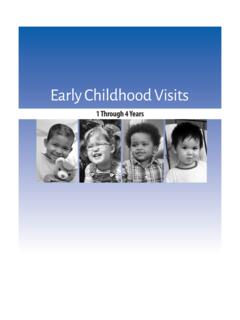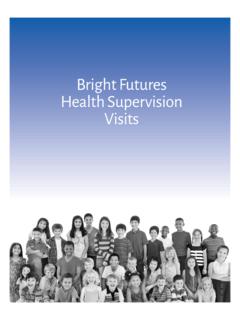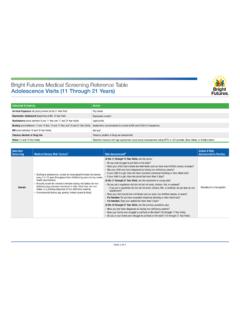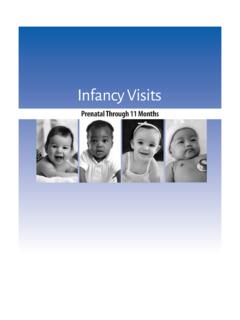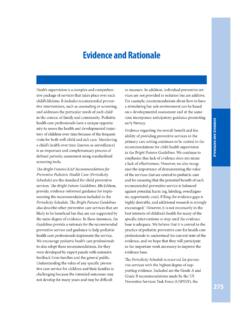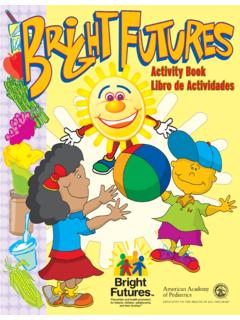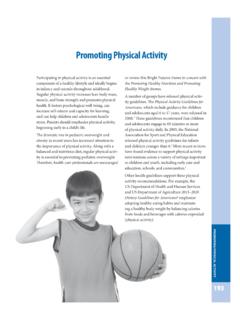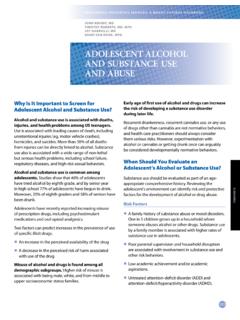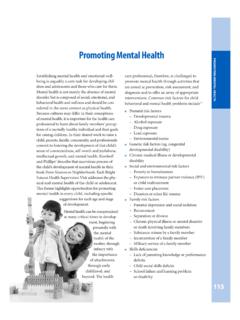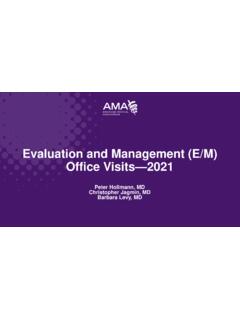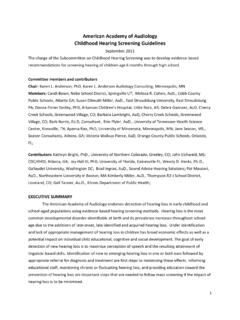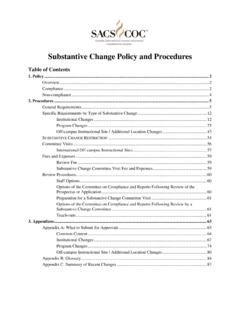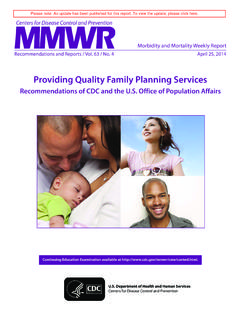Transcription of Middle Childhood Visits - American Academy of Pediatrics
1 5 Through 10 YearsMiddle Childhood VisitsBFG 4TH 6491/20/17 2:47 PM651 Middle CHILDHOOD5 AND 6 YEAR VISITSM iddle Childhood5 and 6 Year VisitsContextAs the Middle Childhood stage begins, boys and girls are growing steadily and their physical com-petence continues to increase. Their improved language and communication skills match social competence to physical ability. They are prepared to move out of home care and child care or pre-school. At this age, they are ready for school is a major milestone for the 5- or 6-year-old and her family. As she prepares to enter kindergarten or elementary school, key develop-mental issues emerge, such as her readiness for school and her ability to separate from her parents. The 5-year-old who has attended preschool or has been in child care out of the home may be able to separate from her parents more easily than the child who has stayed at home.
2 Most 6-year-olds will have attended kindergarten and acquired the social skills necessary for learning in a full-day, first-grade setting. By observing how the child responds to new situations, the parents, teacher, and health care professional can anticipate how temperament and experience may affect school readiness and competence. The 5 and 6 Year Visits permit observation of the child s ability to follow directions, as well as her language skills, maturity level, and motor school brings new opportunities, chal-lenges, and rules for children. School activities require increased ability to function in a group setting, which requires greater impulse control and social skills. Children are expected to obey rules, get along with others, and avoid disruptive behavior. Paying attention to teachers and other adults can be difficult for some children.
3 Acquiring skills in listening, reading, and math excites some children and challenges others. Children enter-ing kindergarten will have many opportunities to make friends, conquer new tasks, and meet other families. They may go on school field trips or par-ticipate in after-school activities. They will need to adjust to school routines, such as eating at school with self-service lunches or designated times for lunch and snacks. Most will manage these new challenges gracefully, while others will strug-gle to learn appropriate behaviors during these transitions. Parents should listen to their child s feelings, encourage her, and praise her efforts and accomplishments. A child s progress in school is an important fac-tor in her development at this age. School-based assessments and report cards are used to track her progress. A child with special health care needs, with disabilities or developmental delay, may qualify for an Individualized Education Program (IEP) or a Section 504 Plan.
4 If she received services through her community s early Childhood special education services program, inquiry regarding transition from this program to kindergarten is appropriate. The goal is always to have the child in the least restrictive environment that also promotes academic, social, and emotional every child is immediately successful in the school experience. Adjustment difficulties, anxi-ety, or psychosocial stressors must be addressed. Children who present with learning, academic, or behavioral problems and symptoms of inattention, BFG 4TH 6511/20/17 2:47 PMBright Futures guidelines for Health Supervision of Infants, Children, and Adolescents652 Middle CHILDHOOD5 AND 6 YEAR Visits hyperactivity, or impulsivity should be evalu-ated for attention-deficit/hyperactivity disorder (ADHD) and for anxiety and learning disability1 as well as for prenatal alcohol and other expo-sures associated with attention problems.
5 Federal education law requires school systems to evaluate children who are experiencing learning or devel-opmental difficulties. Some families may need help finding individuals who can help them advocate for the exact services they need. Each family will have its own perspective on how their child is performing in school. A child will perform best if she feels there is consistency between the expectations of the school and her family regarding educational performance and behavior at school. Some teaching styles may not be the best fit for some children (eg, an overly nurturing teacher may not have firm expecta-tions that some children need and an overly rigid teacher might not provide the flexibility and sup-port needed for other children, especially those who are anxious). In addition, parents sometimes need help in understanding the significance of par-ticular academic struggles.
6 The concept of a learn-ing disability or learning difference may not make sense within certain cultural beliefs about health or abilities. It is essential to identify areas of strength and weakness so that interventions can be put in place early for any areas of vulnerability. Families who are newly immigrated may not understand the US educational system and may need guidance about what to expect and how they can be involved in supporting their child in school. A language mismatch can be an added barrier between the teacher and parent communication. It may be helpful to have a parent advocate present at educational meetings. If English is not spoken at home, health care professionals should assess the child s exposure to English and what resources are needed to support the important learning tasks ahead. Health care professionals will support mul-tilingual or bilingual language is developmentally appropriate for 5- and 6-year-olds to spend increasing amounts of time with friends and others outside the home.
7 Parents should meet these new friends and their families. Parents need to encourage their child s friendships and respect the growing influence of peers. Rules and behavioral expectations will vary among fami-lies, especially across cultures. As children this age acquire new experiences, they normally begin to test whether the rules can change now that they are older. Some rules can be loosened, but others must be maintained in the interest of sustaining appro-priate behavior, providing emotional security and personal safety, and promoting moral children younger than 5 years have been exposed to the digital world. The 5-year-old is often fascinated by the online world and her ability to become involved with it. With emerging reading and fine motor skills, some will become skilled with the computer and the Internet. However, chil-dren this age and throughout Childhood still need strong and frequent parental supervision and mon-itoring to ensure that they are not exposed to inap-propriate materials.
8 Parents may consider getting child-specific browsers and setting up a favorite s toolbar so the child can go only to approved Web sites. Parents also should use an Internet safety tool to limit access to content, Web sites, and activities. It is always important to balance computer and online time with active play. Setting limits on sed-entary activities can help children remain active and hazards, such as matches, cigarette lighters, gas stoves, and fireplaces, often fascinate 5- and 6-year-olds. This is especially true for children who tend to be impulsive. Thus, parents should remember to keep matches, lighters, and cigarette and e-cigarette paraphernalia out of reach, and to remind children that these items are not toys. Parents should be cautioned specifically about the dangers of keeping firearms in the home and informed of the importance of keeping all firearms BFG 4TH 6521/20/17 2:47 PMBright Futures guidelines for Health Supervision of Infants, Children, and Adolescents653 Middle CHILDHOOD5 AND 6 YEAR Visits locked up, with the ammunition locked separately and the keys in a place their child cannot access.
9 It is critical that children continue to use appropriate car safety seats and booster seats. By her sixth birthday, a child is eager to act inde-pendently, but she is not yet able to consistently make good decisions. She likes to climb trees or fire escapes and play in the yard or on the side-walk with other children, but she is still learning about safety. Children must learn to be safe at home, at school, on the playground, and in the neighborhood. Families will need to continue to set appropriate boundaries and other limits while encouraging and promoting their child s growing independence. Before she is ready to start explor-ing the community on her own, she must be able to remember and understand safety rules well enough to interpret them and adapt them for different situ-ations. Children need frequent reminders on rules for interacting with and avoiding strangers, as well as instructions on telephone numbers to call for help in case of emergencies.
10 At this age, most chil-dren are riding bicycles or using skates and may be learning to use skateboards and to swim. Parents need to teach their child, and frequently review, the safety rules for playing on the playground, riding a bicycle in the neighborhood, and engaging in other recreational activities. Children this age are not yet ready to cross the street alone, and adult supervision also is needed for swimming and other water sports. A child s bicycle should be suited to her ability level and adjusted to her size. She should always wear an approved helmet and protective equipment when riding a bike, skateboarding, skating, or playing in organized sports. Parents need to model this child s community affects safety concerns because the setting and seasonal climate determine common activities and risks. Traffic crashes and playing around cars are health risks for the young child.
